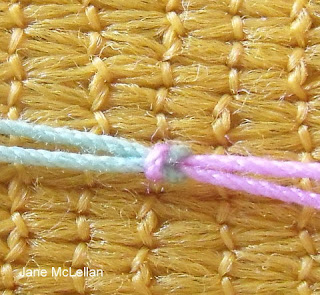Six little flowers need to be made first in two colours! That's a lot of ends to deal with. Some thoughts: I tied the threads together with a reef knot so that I was just hiding the ends in the first ring and chain, rather than securing them.
I don't know if it's my imagination, but I think that if I snip the hidden thread after the first half of a ds, rather than after a complete stitch, I get a smoother look. I was a bit worried about dislodging the ends when I made the final join, so I cut the threads before making the join and then sewed them in instead of using a hook.
My easy thread needles do make the job a bit simpler!
Once the flowers were made, the rest of the tat went smoothly. Joining the little flowers in is perfectly straight forward.





It's a lovely motif - but I see your point about the ends. I usually just tat over tails in the beginning, and then sew in the ends when I'm finished - you don't tat over the beginning tails all the way round that first ring and chain, so there is plenty of scope for ending off. But I find the easy-threading needles are too thick for my tension - I use the finest needles I can get the threads through!
ReplyDeleteThat's SO pretty. I use a weaver's knot to tie the two ends together and then cover them (like you did) in the first ring and chain. The weaver's knot tends to be a bit less bulky. Like you did - I thread the needle (just LOVE those self threading ones) take the one thread through the joining place, but then I tie an overhand knot and sew in that end and then the other end. Having said all that I must admit to avoiding patterns where there are too many 'small parts' but only cause I'm a lazy moo.
ReplyDeleteI understand what you're saying about looking at those tiny flowers and thinking of hiding all those ends. I felt the same way about Mary Konior's Primrose Path. However, once I settled down and got to tatting, I was very glad I took the plunge!
ReplyDeleteI also snip the thread after the first half of the ds. Somehow, it seems that the end of the thread doesn't pop out as much.
Very pretty motif, my favourite till now!
ReplyDeletethis is beautiful to see and love the knot tips and I really don't mind tying off knots cause the color change is so beautiful it doesn't stress me out. I am impressed with your chains at the start and will work on this someday (I avoided this pattern)ha ha ha
ReplyDeleteFabulous motif!!! :)
ReplyDeleteMost tatters take a moment to decide if a pattern is worth the effort when there are a lot of individual parts like this. We like tatting, not the necessary evils of hiding ends! It turned out very well.
ReplyDeleteInteresting comments, thanks.
ReplyDeleteThis is a lovely motif, even if one has to make the flowers first.
ReplyDeleteNot sure if I am interpreting all this correctly - for a change. I snip on the "wrong"side," if I do not want to see ends... That would be after either the first or second stitch, willy-nilly! Perhaps I should try it after the first to see if it males a difference... Interesting.
ReplyDeleteThat makes sense. I don't do front side back side tatting so I don't have a wrong side.
ReplyDeleteThat is my thinking, too. I was beginning to feel like the only one!
DeleteAnother lovely motif !!! Following your journey has put this book on my to-buy list :-)
ReplyDeleteYour reef knot idea is very interesting ! Must try it out. I don't make any kind of knot when starting; fold the 2 threads over each other & tat over each tail within the elements.
Not your imagination at all ! Stopping &/or snipping after half stitch does make for a neat closure & the reason has to do with a hint in my last post (under points to ponder) - it depends on the where the core thread is : after fhs, it emerges at the back & after shs it emerges from the front. One can make the adjustment for fs/bs.